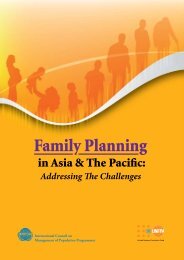Inter-lInkages between PoPulatIon DynamIcs anD DeveloPment In ...
Inter-lInkages between PoPulatIon DynamIcs anD DeveloPment In ...
Inter-lInkages between PoPulatIon DynamIcs anD DeveloPment In ...
Create successful ePaper yourself
Turn your PDF publications into a flip-book with our unique Google optimized e-Paper software.
For <strong>In</strong>dia and Malaysia, however, this is even more important at state level as there is considerable diversityboth in the population dynamics and development status of states. Therefore, each state plan needs toconsider the inter-linkages <strong>between</strong> population dynamics and development planning. However, state plansinadequately integrate consideration of population dynamics in their development plans. Two actions arenecessary to remedy the situation: (i) there needs to be a focal point for this purpose, and (ii) this needs to besupported by modelling to indicate the effect of population dynamics on development as well as estimatedimpact of different development interventions on population dynamics. <strong>In</strong> <strong>In</strong>dia, there is a network of PopulationResearch Centres which can carry out this task. However, some fillip to this effort is necessary from theCentres as well as from development partner agencies. This will result in more effective response.Coordinated sectoral response at district level. The district is a key administrative unit and has anappropriate organisational structure headed by an appropriate official (Deputy Commissioner or district officialsin Bangladesh; District Collector, District Development Officer or a Deputy Commissioner in <strong>In</strong>dia; and DistrictOfficer in Malaysia). Certain sectors could coordinate implementation of their plans to include responding toPOPDEV inter-linkages, which will provide synergistic responses. For example, the health sector provides FP/RH services and the environment sector in coordination educates communities on the impact of populationgrowth on the environment. Similarly, the health sector provides FP/RH services and the women’s affairssector in coordination educates young women on FP/RH and the association <strong>between</strong> having a small familyand higher investment per child, as well as on gender-based violence. For this to materialise, it is essentialto establish protocols, formulate procedures and build capacities for a coordinated response.Cross-sectoral collaboration at sub-district/Upazila level/block. Two or more sectors can collaborate toaddress POPDEV inter-linkages, which would increase efficiency in resource utilization. The adolescent andhealth sectors could collaborate to provide ARH education and services, including HIV prevention concurrently.Similarly, health and education sectors can collaborate for school health and provide age-appropriate populationand health education, including RH. For such collaboration to materialise beyond sectoral boundaries,protocols and procedures need to be in place.<strong>In</strong>tegrated response at Union/village level. A community may consider a development approach thatincludes POPDEV inter-linkages. This will result in enhanced community participation and more effectiveapproach in addressing the root causes of poverty, gender inequality and underdevelopment in some areas.<strong>In</strong> <strong>In</strong>dia, the 73 rd and 74 th amendments in the constitution of <strong>In</strong>dia provide a statutory framework for integratingpopulation dynamics in the development response at the village level.Overall, each higher level of POPDEV inter-linkages will be applicable to increasingly smaller geographicadministrative units. To succeed, the national and district levels need to increase resource allocation for keysectors, namely, gender, adolescent, HIV/AIDS, and health for FP/RH services, where POPDEV inter-linkagesare strong but often underfunded.40














